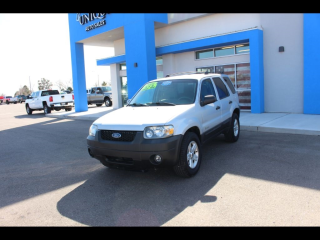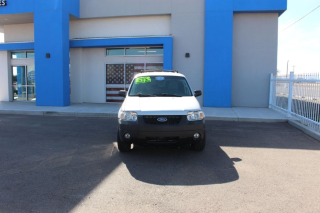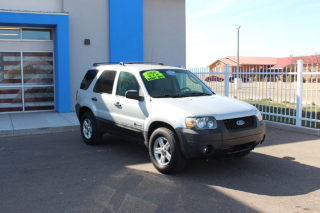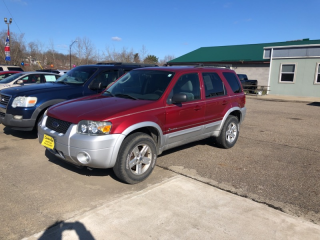The 2006 Ford Escape Hybrid, part of the first generation Escape (2001-2012), debuted as one of the first hybrid SUVs. This compact SUV was offered in a single, well-equipped trim level, primarily targeting environmentally conscious buyers seeking practicality. Its popularity stemmed from its groundbreaking hybrid technology in a readily accessible format and a starting MSRP around $30,000, making it a compelling option for those prioritizing fuel efficiency in an SUV.
The Good
The 2006 Escape Hybrid excels in fuel efficiency, offering significant savings at the pump. Its comfortable ride and practical SUV design appeal to families, while its pioneering hybrid technology satisfies eco-conscious desires and promises a forward-thinking ownership experience.
The Bad
Owners should be aware of potential issues with the hybrid battery pack, which can be costly to replace. Transmission problems, electrical gremlins, and brake wear are also commonly reported concerns that require attention during ownership.
2006 Ford Escape Hybrid: Quick Overview
- Engine Options: The 2006 Ford Escape Hybrid exclusively features a 2.3L 4-cylinder gasoline engine paired with an electric motor and a Nickel-Metal Hydride (NiMH) battery pack.
- Horsepower: The combined system output is rated at approximately 153 horsepower.
- Fuel Economy: This is where the Escape Hybrid shines. It achieves an EPA estimated 30 MPG in the city and 28 MPG on the highway, offering substantial fuel savings over conventional SUVs.
- 0-60 Times: Acceleration is not a strong suit for the Escape Hybrid, with 0-60 mph times typically in the 10-11 second range, reflecting its focus on efficiency rather than outright performance.
- Towing Capacity: The towing capacity for the 2006 Ford Escape Hybrid is limited to 1,000 pounds, suitable for small trailers or recreational equipment.
- Trim-Level Features: The 2006 Ford Escape Hybrid was offered in a single, well-appointed trim. Standard features often included:
- Leather upholstery
- Heated front seats
- Power driver's seat
- Dual-zone automatic climate control
- Premium audio system with CD player
- Keyless entry
- Roof rails
- 16-inch alloy wheels
- Anti-lock brakes (ABS)
- Front and side-curtain airbags
- Traction control
2006 Ford Escape Hybrid Specifications
Vehicle Information
| Year | 2006 |
| Make | Ford |
| Model | Escape Hybrid |
| Trim | - |
| Style | Front-Wheel Drive |
| Type | Sport Utility Vehicle |
| Category | Standard Sport Utility Vehicle |
Manufacturing Details
| Made In | United States |
| Manufacturing City | KANSAS CITY |
Dimensions
| Doors | 4-Door |
| Curb Weight | 3627 pounds |
| Gross Vehicle Weight Rating | 5000 pounds |
| Overall Height | 70.40 inches |
| Overall Length | 174.90 inches |
| Overall Width | 70.10 inches |
| Wheelbase Length | 103.10 inches |
| Standard Seating | 5 |
Engine & Performance
| Engine | 2.3-L L-4 DOHC 16V Hybrid |
| Engine Size | 2.3L |
| Engine Cylinders | 4 |
| Transmission | Continuously Variable Transmission |
| Transmission Type | Automatic |
| Transmission Speeds | Continuously Variable |
| Drivetrain | Front-Wheel Drive |
Additional Features
| Anti-Brake System | 4-Wheel ABS |
| Steering Type | Rack & Pinion |
Pricing
| Manufacturer Suggested Retail Price (MSRP) | $26,900 |
| Invoice Price | $25,049 |
| Delivery Charges | $615 |
Vehicle History Report
Vehicle
Specifications
Specifications
Ownership
History
History
All History
Events
Events
NMVTIS Title
History Check
History Check
Salvage/Rebuilt
Check
Check
Accident
Check
Check
Theft
Check
Check
Open Lien
Check
Check
Past Sale
Listings
Listings
Safety
Recalls
Recalls
Odometer
Check
Check
Market Price
Analysis
Analysis
What Problems Does the 2006 Ford Escape Hybrid Have?
The 2006 Ford Escape Hybrid, while innovative for its time, is not without its common issues. A significant concern for owners is the potential failure of the hybrid battery pack. These batteries have a finite lifespan, and replacement can be very expensive, often costing several thousand dollars. This is a long-term reliability concern that buyers should be prepared for.
Another frequently reported problem revolves around the transmission, particularly the Continuously Variable Transmission (CVT) or hybrid transaxle. Issues can include rough shifting, whining noises, and eventual failure, necessitating costly repairs or replacements. Electrical gremlins are also not uncommon, with owners reporting issues with various electronic components, including the power inverter, sensors, and dashboard displays.
Brake wear is another area where the Escape Hybrid can be problematic. While the regenerative braking system helps extend brake life, some owners still report premature wear on brake pads and rotors. Suspension components, such as ball joints and control arms, can also wear out over time, leading to clunking noises and compromised handling.
While specific recalls for the 2006 model year might be limited, it is always advisable to check the National Highway Traffic Safety Administration (NHTSA) website for any outstanding safety recalls that may apply. The long-term reliability of the hybrid components, especially the battery, is a primary concern. While well-maintained examples can still perform admirably, potential buyers should factor in the possibility of significant repair costs down the line, particularly as the vehicle ages and accumulates mileage.
Another frequently reported problem revolves around the transmission, particularly the Continuously Variable Transmission (CVT) or hybrid transaxle. Issues can include rough shifting, whining noises, and eventual failure, necessitating costly repairs or replacements. Electrical gremlins are also not uncommon, with owners reporting issues with various electronic components, including the power inverter, sensors, and dashboard displays.
Brake wear is another area where the Escape Hybrid can be problematic. While the regenerative braking system helps extend brake life, some owners still report premature wear on brake pads and rotors. Suspension components, such as ball joints and control arms, can also wear out over time, leading to clunking noises and compromised handling.
While specific recalls for the 2006 model year might be limited, it is always advisable to check the National Highway Traffic Safety Administration (NHTSA) website for any outstanding safety recalls that may apply. The long-term reliability of the hybrid components, especially the battery, is a primary concern. While well-maintained examples can still perform admirably, potential buyers should factor in the possibility of significant repair costs down the line, particularly as the vehicle ages and accumulates mileage.
How long will the 2006 Ford Escape Hybrid last?
Based on owner data and anecdotal evidence, a well-maintained 2006 Ford Escape Hybrid can realistically last between 150,000 to 200,000 miles, and in some cases, even more. However, its longevity is heavily dependent on consistent and proactive maintenance. The hybrid battery pack is a critical component that typically lasts between 8 to 15 years or roughly 100,000 to 150,000 miles before significant degradation occurs, potentially requiring replacement. Weaknesses over time often manifest as issues with the hybrid system itself, transmission problems, and aging electrical components. Regular fluid changes, especially for the hybrid transaxle, and diligent attention to any warning lights are crucial for extending its service life. Neglecting maintenance, particularly of the hybrid-specific systems, can significantly shorten its durable lifespan.
What Technology & Safety Features are Included?
The 2006 Ford Escape Hybrid offered a respectable suite of technology and safety features for its era, with a focus on convenience and occupant protection. Standard entertainment typically included an AM/FM stereo with a CD player and four speakers. An optional premium audio system with more speakers and a subwoofer was available, enhancing the listening experience.
In terms of technology, the climate control system was often dual-zone automatic, allowing drivers and front passengers to set individual temperature preferences. Keyless entry was also a common feature, adding to the vehicle's convenience. A notable optional feature was the DVD-based navigation system, which was cutting-edge for its time, though its functionality and screen resolution would be considered basic by today's standards.
Driver-assistance features were limited in 2006. The vehicle came standard with anti-lock brakes (ABS) and traction control, which aided in maintaining stability and control during braking and acceleration.
Safety was a priority, with the Escape Hybrid equipped with front-seat side airbags and full-length side-curtain airbags, providing enhanced protection for occupants in the event of a side impact. The SUV body style also offers a higher seating position, which some drivers prefer for visibility.
Regarding crash-test ratings, the 2006 Ford Escape (including the hybrid variant) performed reasonably well for its time. It received good ratings in frontal and side-impact crash tests from the Insurance Institute for Highway Safety (IIHS). It was awarded an "Acceptable" rating in the frontal offset test and a "Good" rating in the side impact test. For the National Highway Traffic Safety Administration (NHTSA), it earned four out of five stars for both driver and front passenger in frontal impacts and four out of five stars for side-impact protection.
In terms of technology, the climate control system was often dual-zone automatic, allowing drivers and front passengers to set individual temperature preferences. Keyless entry was also a common feature, adding to the vehicle's convenience. A notable optional feature was the DVD-based navigation system, which was cutting-edge for its time, though its functionality and screen resolution would be considered basic by today's standards.
Driver-assistance features were limited in 2006. The vehicle came standard with anti-lock brakes (ABS) and traction control, which aided in maintaining stability and control during braking and acceleration.
Safety was a priority, with the Escape Hybrid equipped with front-seat side airbags and full-length side-curtain airbags, providing enhanced protection for occupants in the event of a side impact. The SUV body style also offers a higher seating position, which some drivers prefer for visibility.
Regarding crash-test ratings, the 2006 Ford Escape (including the hybrid variant) performed reasonably well for its time. It received good ratings in frontal and side-impact crash tests from the Insurance Institute for Highway Safety (IIHS). It was awarded an "Acceptable" rating in the frontal offset test and a "Good" rating in the side impact test. For the National Highway Traffic Safety Administration (NHTSA), it earned four out of five stars for both driver and front passenger in frontal impacts and four out of five stars for side-impact protection.
What Colors Options are Available?
Exterior Colors
Oxford White
Black
Triton Blue Metallic
Dark Shadow Grey
Redfire Metallic
Desert Bronze Metallic
Natural Tan Metallic
Silver Birch Metallic
Dark Toreador Red Metallic
Medium Steel Blue
Interior Colors
Adobe
Pewter
Medium Parchment
Black
2006 Ford Escape Hybrid Prices and Market Value
When new, the 2006 Ford Escape Hybrid had a starting MSRP of around $30,000, with higher-end configurations potentially reaching into the mid-$30,000s. As a pioneering hybrid SUV, it commanded a premium over its gasoline-only counterpart. Today, used market prices for the 2006 Ford Escape Hybrid typically range from $3,000 to $8,000, depending heavily on mileage, overall condition, and the remaining life of the hybrid battery. Depreciation has been significant, as is typical for most vehicles, especially with hybrid technology that has since advanced. Factors affecting resale value include the documented service history, the reported health of the hybrid battery, and the presence of any known mechanical issues. Lower mileage and a well-maintained example will always fetch a higher price.
2006 Ford Escape Hybrid Cost of Ownership
The 2006 Ford Escape Hybrid is generally economical to own, primarily due to its excellent fuel efficiency, which significantly reduces annual fuel costs. Insurance rates are typically comparable to other compact SUVs, though hybrid-specific components might influence some policies. Maintenance costs can be moderate, with routine services being standard. However, repair costs can escalate if hybrid-specific components like the battery pack or inverter require attention, which can be expensive. Long-term ownership costs are a mixed bag: low fuel expenses are a major plus, but the potential for significant hybrid component repairs means owners should budget for unexpected expenses to keep it economical.
2006 Ford Escape Hybrid Fuel Efficiency
Fuel Type
Hybrid
Fuel Capacity
15.00 gallons
City Mileage
36 miles/gallon
Highway Mileage
31 miles/gallon
2006 Ford Escape Hybrid Safety Rating
NHTSA
IIHS
2006 Ford Escape Hybrid Warranty
Basic
Original warranty
36 months / 36,000 miles
Estimated remaining
Expired
Powertrain
Original warranty
36 months / 36,000 miles
Estimated remaining
Expired
Rust
Original warranty
60 months / unlimited miles
Estimated remaining
Expired
2006 Ford Escape Hybrid Insurance
Insurance for a 2006 Ford Escape Hybrid is moderately priced, reflecting its status as a Sport Utility Vehicle with strong safety ratings and
reasonable repair costs.
reasonable repair costs.
How Does the 2006 Ford Escape Hybrid Compare to Other Sport Utility Vehicle?
The 2006 Ford Escape Hybrid occupied a unique niche as one of the earliest hybrid SUVs. In terms of performance, it lagged behind many gasoline-powered rivals like the Honda CR-V or Toyota RAV4, offering slower acceleration due to its focus on fuel economy. Its fuel efficiency, however, was a significant advantage, often besting competitors in city driving.
Features-wise, the Escape Hybrid was fairly well-equipped for its time, offering leather and heated seats, which were competitive. However, rivals like the Toyota RAV4 sometimes offered more advanced optional technology or a more refined interior.
Reliability is a mixed bag. While the core Ford Escape platform was generally solid, the hybrid system introduced complexities. Early hybrid battery technology could be a concern long-term, unlike the more established reliability of gasoline-powered alternatives such as the Honda CR-V. Toyota's hybrid system in vehicles like the Highlander Hybrid (though a larger class) was generally regarded as more robust.
Price-wise, the Escape Hybrid was significantly more expensive when new than its gasoline counterparts and many rivals. In the used market, its price can be influenced by the hybrid battery's condition, making it potentially a good value if the battery is healthy, or a costly proposition if it's nearing its end of life.
Similar Alternatives: For those seeking a hybrid SUV around this era, the 2006 Toyota Highlander Hybrid (though a larger and more expensive vehicle) offered a more potent hybrid system and generally superior reliability. The 2006 Honda CR-V and Toyota RAV4 are excellent gasoline-powered alternatives if hybrid technology isn't a strict requirement, offering strong reliability, good features, and solid performance at potentially lower used prices. If you prioritize fuel efficiency in a compact SUV but don't need hybrid tech, the gasoline-powered Escape itself, or its aforementioned rivals, would be more straightforward and potentially less risky long-term investments.
Features-wise, the Escape Hybrid was fairly well-equipped for its time, offering leather and heated seats, which were competitive. However, rivals like the Toyota RAV4 sometimes offered more advanced optional technology or a more refined interior.
Reliability is a mixed bag. While the core Ford Escape platform was generally solid, the hybrid system introduced complexities. Early hybrid battery technology could be a concern long-term, unlike the more established reliability of gasoline-powered alternatives such as the Honda CR-V. Toyota's hybrid system in vehicles like the Highlander Hybrid (though a larger class) was generally regarded as more robust.
Price-wise, the Escape Hybrid was significantly more expensive when new than its gasoline counterparts and many rivals. In the used market, its price can be influenced by the hybrid battery's condition, making it potentially a good value if the battery is healthy, or a costly proposition if it's nearing its end of life.
Similar Alternatives: For those seeking a hybrid SUV around this era, the 2006 Toyota Highlander Hybrid (though a larger and more expensive vehicle) offered a more potent hybrid system and generally superior reliability. The 2006 Honda CR-V and Toyota RAV4 are excellent gasoline-powered alternatives if hybrid technology isn't a strict requirement, offering strong reliability, good features, and solid performance at potentially lower used prices. If you prioritize fuel efficiency in a compact SUV but don't need hybrid tech, the gasoline-powered Escape itself, or its aforementioned rivals, would be more straightforward and potentially less risky long-term investments.
Final Verdict: Is the 2006 Ford Escape Hybrid a Good Sport Utility Vehicle?
The 2006 Ford Escape Hybrid is ideal for the environmentally conscious buyer who needs the utility of a compact SUV but prioritizes significant fuel savings, especially in city driving. It's a great option for those who appreciate being an early adopter of hybrid technology and don't require blistering acceleration.
Whether it's worth buying hinges heavily on its current condition and price. As a used vehicle, it can be a compelling purchase if it has a documented history of meticulous maintenance and, crucially, if the hybrid battery is still in good health or has been recently replaced. Buyers should be prepared for the potential for costly repairs related to the hybrid system or transmission. A thorough pre-purchase inspection by a mechanic familiar with hybrid vehicles is highly recommended. It's generally not recommended to buy one if you're on a very tight budget or cannot afford potential future repair bills, as the cost of replacing the hybrid battery can be substantial.
Whether it's worth buying hinges heavily on its current condition and price. As a used vehicle, it can be a compelling purchase if it has a documented history of meticulous maintenance and, crucially, if the hybrid battery is still in good health or has been recently replaced. Buyers should be prepared for the potential for costly repairs related to the hybrid system or transmission. A thorough pre-purchase inspection by a mechanic familiar with hybrid vehicles is highly recommended. It's generally not recommended to buy one if you're on a very tight budget or cannot afford potential future repair bills, as the cost of replacing the hybrid battery can be substantial.





